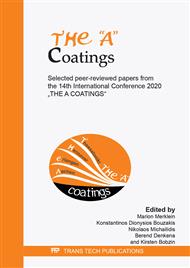p.3
p.11
p.19
p.28
p.39
p.45
p.53
p.61
PVD Coated Tools and Surface-Structured Workpieces in Dry Cold Forming of Steel
Abstract:
Cold forming, particularly forward impact extrusion, is used for mass production of steel components. To ensure robust forming processes, the workpieces are usually phosphated and then soaped as well as mineral oil-based lubricants are used. As these lubricants are often harmful to the environment and health, alternative approaches are to be investigated from an ecological, economic and legislative perspective. To achieve dry, lubricant-free cold forming of steel, two approaches are being pursued here. The tool-sided approach focuses on self-lubricating hard coatings, which are deposited on the forming tools by means of physical vapor deposition (PVD). The developed coating system CrAlN+Mo:S is synthesized in an industrial coating unit by a hybrid sputtering process, which combines direct current (DC) and high power pulsed magnetron sputtering (HPPMS) technology. The coating consists of a hard matrix CrAlN which is modified by Mo and S to provide friction reduction due to the in situ formation of MoS2 reaction layers under tribological load. The workpiece-sided approach focuses on the surface structuring by shot peening with various peening materials and particle shapes. In order to evaluate the influence of the self-lubricating tool coating CrAlN+Mo:S and the various workpiece topographies, dry full forward impact extrusion tests were carried out in an industrial scale with coated and uncoated tools. On the one hand, a one-shouldered die geometry and on the other hand a two-shouldered die geometry were tested. The field trials reveal that for both die geometries, the tool coating significantly reduces the punch force and the wear compared to the uncoated dies. Depending on the workpiece topography, it was shown that a smoother surface leads to reduced adhesive wear. Furthermore, it was proven that the dies with an opening diameter of D = 31.4 mm and an outlet diameter of d = 20.7 mm could be coated continuously over a length of l = 50 mm on the entire inner surface. After the dry field trials, the CrAlN+Mo:S coating remained completely intact. Hence, the developed coating system CrAlN+Mo:S exhibits great potential to conduct dry, lubricant-free cold forming of steel at industrial scale.
Info:
Periodical:
Pages:
19-27
Citation:
Online since:
October 2020
Keywords:
Price:
Сopyright:
© 2020 Trans Tech Publications Ltd. All Rights Reserved
Share:
Citation:


